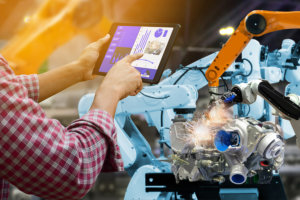 New demands have forced manufacturing automation to change and adapt. Small production runs, fast shipping, nimble operations, robotics, and automation each have unique demands on a manufacturing firm. The ability to meet these demands dictates success or failure.
New demands have forced manufacturing automation to change and adapt. Small production runs, fast shipping, nimble operations, robotics, and automation each have unique demands on a manufacturing firm. The ability to meet these demands dictates success or failure.
One such automation trend is robotics. A full 34 percent of companies plan to add robotics and automation to their supply chain to enhance efficiencies. Experts predict that by 2025, manufacturing automation will include robotics in more than half of all companies.
Manufacturing Automation for Greater Efficiency
Manufacturing automation consists of using systems such as computers or robots, as well as information technology, to handle processes and machines. Although it sounds like it’s taking jobs away from people, it’s actually taking on the repetitive tasks that people find boring.
Originally, manufacturing automation was intended to increase productivity. Companies found that automation ensured a consistency on repetitive tasks. When a person has to rivet a bolt on a car fender for hours on end, they can get tired and make mistakes. Machines don’t care if they rivet bolts 24/7.
Automation was useful for large-scale, homogenous production, but today it’s making inroads into smaller scale manufacturing processes. Scalable, customizable systems are coming online that enable companies to benefit from the same automation as their larger competitors.
Does Automation Put People Out of Work?
There’s a perception that fewer jobs are available in manufacturing, and while that may be true of assembly line work where manufacturing automation excels, new jobs have opened up as the industry changes. Machines require programming and servicing, for example, which may open up job opportunities for engineers, computer programmers, and service personnel.
In other parts of the factory, people must collaborate with machines to perform new work. While the machine can perform repetitive tasks, some tasks rely on the creativity and insight that only a person brings to the job. This new collaboration between human and automation dubbed Industry 5.0 is all about bringing back the human touch. It includes deciding what should be automated and what should not, even if everything can be automated.
Decisions must be made about what should be automated based on the best outcome. For example, automated inspections are generally more efficient and more effective than human inspection. Yet it is when humans’ work is integrated with robots that the best quality product reaches the market.
Entering the World of Automation
Automation brings greater cost and time efficiencies to the manufacturing plant. It’s not going away anytime soon. If you’re keen to enter the world of automation, an easy way to enter is through the use of barcodes.
Barcode technology is everywhere, and it can be useful for quality control, on-line monitoring, classification, and batch tracking. It prevents errors or helps correct errors that occur within the process. Barcodes can also be integrated with inspection processes for optimized line efficiency and continuous improvement. Collecting this data from products allows easy communication through the entire supply chain. Supply chain monitoring becomes easier when items can be tracked using scanners and barcodes.
No, a barcode scanner isn’t as cool as a robot on the factory floor, but it is manufacturing automation, and one that’s helping to improve efficiencies throughout many companies. Small businesses can benefit significantly from incremental improvements such as barcodes.
If you’d like a demonstration of how barcodes and scanners can automate many aspects of your business, contact Emerald TC: 678-456-6919.

